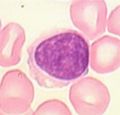Difference between revisions of "Lymphocytes - Introduction"
m (Text replace - "T cell differentiation - WikiBlood" to "T cell differentiation") |
|||
| (21 intermediate revisions by 5 users not shown) | |||
| Line 1: | Line 1: | ||
| − | |||
{| align="right" | {| align="right" | ||
|<gallery perrow="1"> | |<gallery perrow="1"> | ||
| − | Image:LH_Lymphocyte_Histology.jpg|<div style="text-align: center;"><p>'''Lymphocyte'''</p><sup> | + | Image:LH_Lymphocyte_Histology.jpg|<div style="text-align: center;"><p>'''Lymphocyte'''</p><sup>©RVC 2008</sup></div> |
| − | Image:LH_Lymphocytes_Histology.jpg|<div style="text-align: center;"><p>'''Lymphocytes'''</p><sup> | + | Image:LH_Lymphocytes_Histology.jpg|<div style="text-align: center;"><p>'''Lymphocytes'''</p><sup>©RVC 2008</sup></div> |
</gallery> | </gallery> | ||
|} | |} | ||
==Introduction== | ==Introduction== | ||
| − | Lymphocytes account for around a third of all circulating [[Leukocytes|leukocytes]] and are formed in a variety of lymphoid tissues. They are functionally divided into [[T cells]], [[B cells]] and [[Natural Killer | + | Lymphocytes account for around a third of all circulating [[Leukocytes|leukocytes]] and are formed in a variety of lymphoid tissues. They are functionally divided into [[#T cells|T cells]], [[#B cells|B cells]] and [[#Natural Killer (NK) Cells|NK (Natural Killer) cells]]. Lymphocytes vary in size (6-30µm) and are classified as small, medium or large. Large cells are either activated lymphocytes or NK cells. The vast majority of circulating lymphocytes are small and of a similar size to erythrocytes. Histologically they are round with a densely staining nucleus and a thin, often indistinct, rim of cytoplasm. While NK cells can be distinguished by their large granules and kidney shaped nucleus, B and T cells appear the same histologically.</p> |
| − | <p>Lymphocytes, along with | + | <p>Lymphocytes, along with associated supporting cells, form the immune system and recognise antigens, produce antibodies and destroy pathogens.</p> |
==Development== | ==Development== | ||
| − | <p>Both T and B lymphocytes develop from a common stem cell ([[Haematopoiesis - Overview#Colony Forming Units|CFU-L's]]) | + | <p>Both T and B lymphocytes develop from a common stem cell ([[Haematopoiesis - Overview#Colony Forming Units|CFU-L's]]) and for a general overview of this process see [[Leukopoiesis#Lymphopoiesis|here]].</p> |
| + | <p> Follow these links for a more detailed explanation on [[T cell differentiation|T cell development]] and [[B cell differentiation|B cell development]].</p> | ||
| − | |||
| − | |||
| − | |||
| − | |||
| − | |||
| − | |||
| − | |||
| − | |||
| − | |||
| − | |||
| − | |||
| − | |||
| − | |||
| − | |||
| − | |||
[[Category:Lymphocytes|A]] | [[Category:Lymphocytes|A]] | ||
Revision as of 14:54, 13 August 2010
Introduction
Lymphocytes account for around a third of all circulating leukocytes and are formed in a variety of lymphoid tissues. They are functionally divided into T cells, B cells and NK (Natural Killer) cells. Lymphocytes vary in size (6-30µm) and are classified as small, medium or large. Large cells are either activated lymphocytes or NK cells. The vast majority of circulating lymphocytes are small and of a similar size to erythrocytes. Histologically they are round with a densely staining nucleus and a thin, often indistinct, rim of cytoplasm. While NK cells can be distinguished by their large granules and kidney shaped nucleus, B and T cells appear the same histologically.
Lymphocytes, along with associated supporting cells, form the immune system and recognise antigens, produce antibodies and destroy pathogens.
Development
Both T and B lymphocytes develop from a common stem cell (CFU-L's) and for a general overview of this process see here.
Follow these links for a more detailed explanation on T cell development and B cell development.

